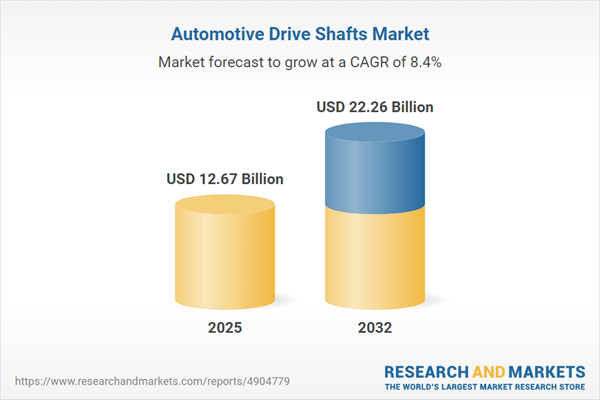Speak directly to the analyst to clarify any post sales queries you may have.
The automotive drive shafts market is undergoing significant transformation driven by technological advancement, regulatory change, and evolving customer demands. As electrification and digitalization reshape the industry, business leaders must stay ahead by leveraging thorough market intelligence, strategic foresight, and comprehensive segmentation analysis.
Market Snapshot: Global Growth in the Automotive Drive Shafts Market
The automotive drive shafts market grew from USD 11.70 billion in 2024 to USD 12.67 billion in 2025. It is expected to continue growing at a CAGR of 8.36%, reaching USD 22.26 billion by 2032. This robust growth trajectory highlights rising demand across traditional and electrified vehicle platforms, sustained by innovations in materials engineering, manufacturing efficiencies, and evolving regional trends under shifting regulatory frameworks.
Scope & Segmentation: Comprehensive Coverage of Demand Drivers and Opportunities
- Vehicle Class: Heavy Commercial Vehicles (bus, truck), Light Commercial Vehicles (pickup, van), Passenger Cars (hatchback, sedan, SUV)
- Material: Aluminum, Composite, Steel
- Application: Propeller Drive Shaft, Steering Shaft
- End User: Aftermarket, OEM
- Regions: Americas (United States, Canada, Mexico, Brazil, Argentina, Chile, Colombia, Peru), Europe, Middle East & Africa (United Kingdom, Germany, France, Russia, Italy, Spain, Netherlands, Sweden, Poland, Switzerland, United Arab Emirates, Saudi Arabia, Qatar, Turkey, Israel, South Africa, Nigeria, Egypt, Kenya), Asia-Pacific (China, India, Japan, Australia, South Korea, Indonesia, Thailand, Malaysia, Singapore, Taiwan)
- Leading Companies Profiled: American Axle & Manufacturing Holdings, Inc.; Dana Incorporated; GKN Driveline Limited; Neapco Holdings LLC; Meritor, Inc.; JTEKT Corporation; NTN Corporation; SKF AB; Sona Comstar Limited; Endurance Technologies Limited
Key Takeaways for Senior Decision-Makers
- Innovation is fueled by the adoption of lightweight materials, advanced simulation tools, and flexible manufacturing processes, responding to demands for efficiency, noise reduction, and component durability.
- Environmental regulations and corporate sustainability initiatives are prompting a reevaluation of drive shaft manufacturing, with increased focus on recyclability, lower carbon footprints, and extended component lifecycles.
- The growth of electric and hybrid powertrains is reshaping torque transmission solutions, requiring integration of composite materials and novel joint architectures for enhanced performance.
- Regional production shifts and electrification trends are influencing material choices and supply chain arrangements, as vehicle manufacturers pursue cost optimization and compliance.
- Collaboration between mechanical and software engineers is vital, especially as autonomous vehicle platforms demand real-time condition monitoring, dynamic balancing, and predictive maintenance capabilities.
- Diversified customer segments, from heavy-duty trucks to passenger sedans, require tailored solutions addressing specific performance, durability, and cost metrics.
Tariff Impact: Navigating US Policy Changes in 2025
Newly implemented tariffs in the United States in 2025 have meaningfully affected the global automotive drive shaft sector. Producers are exploring nearshoring strategies and regional investment to reduce exposure to higher duties, while simultaneously focusing on value-engineering initiatives to preserve price competitiveness. These changes place new importance on agile supply chain design, cross-border partnership optimization, and transparent cost modeling for procurement and compliance teams.
Methodology & Data Sources
This research employs primary data from interviews with senior executives, engineers, and supply chain experts, combined with secondary sources including industry journals, technical publications, and government trade data. Rigorous data triangulation and statistical analysis underpin every insight, ensuring that executive decisions reflect reliable, cross-validated intelligence on the automotive drive shafts market.
Why This Report Matters
- Enables targeted product development and smart resource allocation through granular segmentation by vehicle class, material, application, region, and end user.
- Equips strategy leaders to navigate shifting market dynamics, tariff impacts, and evolving regulatory standards, minimizing risks and seizing growth opportunities.
Conclusion
The future of the automotive drive shafts market relies on adaptive strategies, cross-functional collaboration, and technology-driven innovation. Stakeholders well-positioned with actionable intelligence and agile execution will lead in a landscape defined by electrification, sustainability, and global trade complexities.
Additional Product Information:
- Purchase of this report includes 1 year online access with quarterly updates.
- This report can be updated on request. Please contact our Customer Experience team using the Ask a Question widget on our website.
Table of Contents
3. Executive Summary
4. Market Overview
7. Cumulative Impact of Artificial Intelligence 2025
Companies Mentioned
The companies profiled in this Automotive Drive Shafts market report include:- American Axle & Manufacturing Holdings, Inc.
- Dana Incorporated
- GKN Driveline Limited
- Neapco Holdings LLC
- Meritor, Inc.
- JTEKT Corporation
- NTN Corporation
- SKF AB
- Sona Comstar Limited
- Endurance Technologies Limited
Table Information
| Report Attribute | Details |
|---|---|
| No. of Pages | 181 |
| Published | November 2025 |
| Forecast Period | 2025 - 2032 |
| Estimated Market Value ( USD | $ 12.67 Billion |
| Forecasted Market Value ( USD | $ 22.26 Billion |
| Compound Annual Growth Rate | 8.3% |
| Regions Covered | Global |
| No. of Companies Mentioned | 11 |









